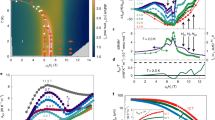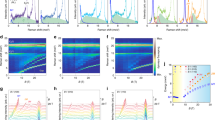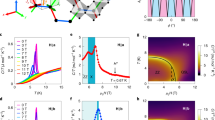Abstract
The honeycomb magnet α-RuCl3 has attracted considerable interest because it is proximate to the Kitaev Hamiltonian whose excitations are Majoranas and vortices. The thermal Hall conductivity κxy of Majorana fermions is predicted to be half-quantized. Half-quantization of κxy/T (T, temperature) was recently reported, but this observation has proven difficult to reproduce. Here, we report detailed measurements of κxy on α-RuCl3 with the magnetic field B ∥ a (zigzag axis). In our experiment, κxy/T is observed to be strongly temperature dependent between 0.5 and 10 K. We show that its temperature profile matches the distinct form expected for topological bosonic modes in a Chern-insulator-like model. Our analysis yields magnon band energies in agreement with spectroscopic experiments. At high B, the spin excitations evolve into magnon-like modes with a Chern number of ~1. The bosonic character is incompatible with half-quantization of κxy/T.
This is a preview of subscription content, access via your institution
Access options
Access Nature and 54 other Nature Portfolio journals
Get Nature+, our best-value online-access subscription
$29.99 / 30 days
cancel any time
Subscribe to this journal
Receive 12 print issues and online access
$259.00 per year
only $21.58 per issue
Buy this article
- Purchase on Springer Link
- Instant access to full article PDF
Prices may be subject to local taxes which are calculated during checkout



Similar content being viewed by others
Data availability
All data are archived in Dataverse: https://dataverse.harvard.edu/dataset.xhtml?persistentId=doi:10.7910/DVN/S6HAKK.
References
Kitaev, A. Anyons in an exactly solved model and beyond. Ann. Phys. 321, 2–111 (2006).
Jackeli, G. & Khaliullin, G. Mott insulators in the strong spin-orbit coupling limit: from Heisenberg to a quantum compass and Kitaev models. Phys. Rev. Lett. 102, 017205 (2009).
Plumb, K. W. et al. α–RuCl3 : a spin-orbit assisted Mott insulator on a honeycomb lattice. Phys. Rev. B 90, 041112 (2014).
Banerjee, A. et al. Proximate Kitaev quantum spin liquid behavior in a honeycomb magnet. Nat. Mater. 15, 733–740 (2016).
Leahy, I. A. et al. Anomalous thermal conductivity and magnetic torque response in the honeycomb magnet α–RuCl3. Phys. Rev. Lett. 118, 187203 (2017).
Banerjee, A. et al. Excitations in the field-induced quantum spin liquid state of α-RuCl3. npj Quantum Mater. 3, 8 (2018).
Hentrich, R. et al. Unusual phonon heat transport in α–RuCl3: strong spin-phonon scattering and field-induced spin gap. Phys. Rev. Lett. 120, 117204 (2018).
McClarty, P. A. et al. Topological magnons in Kitaev magnets at high fields. Phys. Rev. B 98, 060404 (2018).
Joshi, D. G. Topological excitations in the ferromagnetic Kitaev-Heisenberg model. Phys. Rev. B 98, 060405 (2018).
Gordon, J. S., Catuneanu, A., Sørensen, E. S. & Kee, H.-Y. Theory of the field-revealed Kitaev spin liquid. Nat. Commun. 10, 2470 (2019).
Hickey, C. & Trebst, S. Emergence of a field-driven U(1) spin liquid in the Kitaev honeycomb model. Nat. Commun. 10, 530 (2019).
Savary, L. & Balents, L. Quantum spin liquids: a review. Rep. Prog. Phys. 80, 106502 (2017).
Kasahara, Y. et al. Majorana quantization and half-integer thermal quantum Hall effect in a Kitaev spin liquid. Nature 559, 227–231 (2018).
Yokoi, T. et al. Half-integer quantized anomalous thermal Hall effect in the Kitaev candidate α-RuCl3. Science 373, 568–572 (2021).
Czajka, P. et al. Oscillations of the thermal conductivity in the spin-liquid state of α-RuCl3. Nat. Phys. 17, 915–919 (2021).
Bruin, J. A. N. et al. Robustness of the thermal Hall effect close to half-quantization in α-RuCl3. Nat. Phys. 18, 401–405 (2022).
Onose, Y. et al. Observation of the magnon Hall effect. Science 329, 297–299 (2011).
Hirschberger, M., Krizan, J. W., Cava, R. J. & Ong, N. P. Large thermal Hall conductivity of neutral spin excitations in a frustrated quantum magnet. Science 348, 106–109 (2015).
Liang, T. et al. Anomalous Hall effect in ZrTe5. Nat. Phys. 14, 451–455 (2018).
Chern, L. E., Zhang, E. Z. & Kim, Y. B. Sign structure of thermal Hall conductivity and topological magnons for in-plane field polarized Kitaev magnets. Phys. Rev. Lett. 126, 147201 (2021).
Zhang, E. Z., Chern, L. E. & Kim, Y. B. Topological magnons for thermal Hall transport in frustrated magnets with bond-dependent interactions. Phys. Rev. B 103, 174402 (2021).
Utermohlen, F. G. & Trivedi, N. Symmetry analysis of tensors in the honeycomb lattice of edge-sharing octahedra. Phys. Rev. B 103, 155124 (2021).
Matsumoto, R. & Murakami, S. Rotational motion of magnons and the thermal Hall effect. Phys. Rev. B 84, 184406 (2011).
Kane, C. L. & Fisher, M. P. A. Quantized thermal transport in the fractional quantum Hall effect. Phys. Rev. B 55, 15832 (1997).
Ponomaryov, A. N. et al. Unconventional spin dynamics in the honeycomb-lattice material α–RuCl3: high-field electron spin resonance studies. Phys. Rev. B 96, 241107(R) (2017).
Ponomaryov, A. N. et al. Nature of magnetic excitations in the high-field phase of α–RuCl3. Phys. Rev. Lett. 125, 037202 (2020).
Wellm, C. et al. Signatures of low-energy fractionalized excitations in α–RuCl3 from field-dependent microwave absorption. Phys. Rev. B 98, 184408 (2018).
Balz, C. et al. Finite field regime for a quantum spin liquid in α–RuCl3. Phys. Rev. B 100, 060405(R) (2019).
Winter, S. M., Riedl, K., Kaib, D., Coldea, R. & Valenti, R. Probing α–RuCl3 beyond magnetic order: effects of temperature and magnetic field. Phys. Rev. Lett. 120, 077203 (2018).
Villadiego, I. S. Pseudoscalar U(1) spin liquids in α–RuCl3. Phys. Rev. B 104, 195149 (2021).
Acknowledgements
We acknowledge useful discussions with I. Sodemann and S. Todadri. P.C., T.G., N.Q. and N.P.O. were supported by the US Department of Energy (DE-SC0017863), by a Materials Research Science and Engineering Centers award from the US National Science Foundation (DMR 2011750) and by the Gordon and Betty Moore Foundation EPiQS initiative through grant GBMF9466 (to N.P.O.). A.B. and S.E.N. were supported by the Quantum Science Center, a National Quantum Information Science Research Center of the US Department of Energy. P.L.-K. and D.G.M. were supported by the Gordon and Betty Moore Foundation’s EPiQS initiative through grant GBMF9069.
Author information
Authors and Affiliations
Contributions
P.C. performed the measurements and analysed the data with N.P.O.; P.C., T.G. and N.P.O. conceptualized the experiment, which employs a methodology developed by them and M.H. The crystals were grown and characterized at Oak Ridge National Laboratory by P.L.-K., A.B., D.G.M. and S.E.N.; N.Q. performed the precision measurements of the experimentally relevant sample dimensions. The manuscript was written by P.C. and N.P.O. with input from all authors.
Corresponding author
Ethics declarations
Competing interests
The authors declare no competing interests.
Peer review
Peer review information
Nature Materials thanks Joseph P. Heremans and the other, anonymous, reviewer(s) for their contribution to the peer review of this work.
Additional information
Publisher’s note Springer Nature remains neutral with regard to jurisdictional claims in published maps and institutional affiliations.
Extended data
Extended Data Fig. 1 Image of crystal S3.
The three thermometers used for temperature measurements are labeled (TA, TB, TC) as shown.
Extended Data Fig. 2 Time trace of temperature readings in a field-step sequence.
The inset depicts the same data over a narrower time window so that the timescales for the relaxation process can be seen.
Supplementary information
Supplementary Information
Supplementary Figs. 1–12 and Discussion Sections 1–9.
Rights and permissions
Springer Nature or its licensor (e.g. a society or other partner) holds exclusive rights to this article under a publishing agreement with the author(s) or other rightsholder(s); author self-archiving of the accepted manuscript version of this article is solely governed by the terms of such publishing agreement and applicable law.
About this article
Cite this article
Czajka, P., Gao, T., Hirschberger, M. et al. Planar thermal Hall effect of topological bosons in the Kitaev magnet α-RuCl3. Nat. Mater. 22, 36–41 (2023). https://doi.org/10.1038/s41563-022-01397-w
Received:
Accepted:
Published:
Issue Date:
DOI: https://doi.org/10.1038/s41563-022-01397-w
This article is cited by
-
Phonon chirality from impurity scattering in the antiferromagnetic phase of Sr2IrO4
Nature Physics (2024)
-
Planar thermal Hall effect from phonons in a Kitaev candidate material
Nature Communications (2024)
-
Electric polarization near vortices in the extended Kitaev model
npj Quantum Materials (2024)
-
Phonon thermal transport shaped by strong spin-phonon scattering in a Kitaev material Na2Co2TeO6
npj Quantum Materials (2024)
-
Thermal Hall effects due to topological spin fluctuations in YMnO3
Nature Communications (2024)



